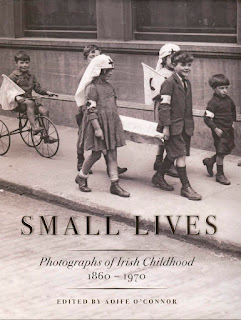The is the first post in my new series of blog posts - From my Bookshelf.
I treated myself to a couple of books for Christmas - not that I need an excuse!
Small Lives - Photographs of Irish Childhood 1860-1970 which is edited by Aoife O'Connor arrived this morning.
I treated myself to a couple of books for Christmas - not that I need an excuse!
Small Lives - Photographs of Irish Childhood 1860-1970 which is edited by Aoife O'Connor arrived this morning.
This book contains a wonderful collection of images taken over a hundred and ten year period in Ireland. Images include those from the city and country, those from wealthy families and extremely poor ones and those at work and at play. The differences between the rich and poor are often quite distressing.
As usual when I looked at this book I made a note of things that I hadn't been aware of or had not stopped to think about. Which photographs made me think of specific Irish families in my family? What did I find interesting?
- Although I knew that little boys were often dressed in dresses, I was surprised to see boys as old as 12 dressed this way.
- I had not stopped to think about what happened to families who had been evicted from their homes. An image of a family sheltering in a hut made of dry-stone walling and sod had me considering if any of my families ever lived like this.
- I didn't know about bathing machines where women were wheeled out into the sea so they could enter and leave the water without being seen.
- There are four photographs of children with donkeys. In one, the creel (basket) is loaded with turf. This is probably the way my Agnew family carted their turf. (I have documentation to say they lived near a bog.)
I wonder
- which women in my families were proficient lace makers?
- did any of them live in a workhouse?
- did any of them keep pigs?
- did they own a spinning wheel?
- did they use sack cloths for capes?
- did they have a quern stone to grind grain?
- if they didn't go to school because of a lack of suitable clothing?
OR
I wonder
- did they get pushed in Dublin in a back-to-back perambulator for two?
- did they cycle along the promenade?
- did they pose in their best clothes for a studio portrait?
- did they go to a school with walls covered with maps and science diagrams?
I can probably answer yes to all of the above. My Irish families are quite a mixed lot - from wealthy Church of Ireland Irish living just north of Dublin, Scottish Presbyterians from Antrim (and probably before that from Scotland), and Catholics from Derry, Waterford, Clare, Tipperary and Cork.
Small Lives was a photographic exhibition held at the National Photographic Archive Templebar from August 2011 until June 2012. You can also see some of the images on the National Library of Ireland Flickr page.
If you have Irish ancestry this book is certainly worth purchasing.
Why not share your bookshelf too!

Sharon, How can I sneak another book into my house?
ReplyDeleteI think Mr Geniaus now realises that it isn't my bookshelves that are growing but my book collection growing.